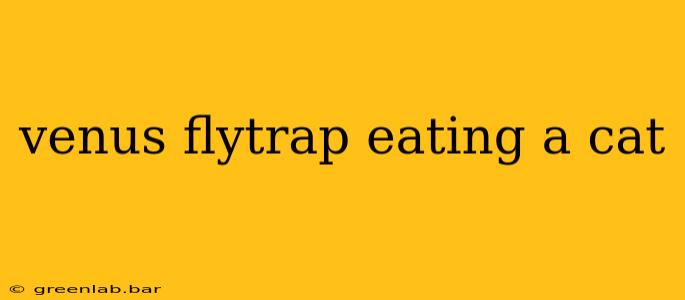The image of a Venus flytrap consuming a cat is, thankfully, purely fictional. While these fascinating carnivorous plants are capable of trapping and digesting insects, their size and mechanism simply wouldn't allow them to prey on anything as large as a cat. This article will explore the realities of Venus flytraps, address the misconception of them eating cats, and delve into the plant's natural diet and capabilities.
Understanding the Venus Flytrap's Diet
Venus flytraps ( Dionaea muscipula) are native to subtropical wetlands in the United States. Their unique trapping mechanism, comprised of modified leaves that snap shut when triggered, is an adaptation to nutrient-poor environments. They supplement their nutrient intake, primarily nitrogen and phosphorus, by capturing and digesting insects and other small arthropods.
What Do Venus Flytraps Eat?
Their diet primarily consists of:
- Insects: Flies, ants, spiders, and beetles are common prey.
- Small Arthropods: Other small invertebrates like springtails and other crawling creatures.
The trap's sensitive trigger hairs detect movement and pressure. Multiple triggers within a short timeframe initiate the snapping action. Once closed, the trap secretes enzymes to break down the prey, absorbing its nutrients. After digestion (which can take several days), the trap reopens.
Why the Myth of a Cat-Eating Venus Flytrap Persists
The idea of a Venus flytrap consuming a cat likely stems from a combination of factors:
- Exaggerated Perceptions of Carnivorous Plants: The dramatic nature of the flytrap's trapping mechanism often fuels fantastical stories and misconceptions.
- Internet Sensationalism: Outlandish claims and distorted images spread quickly online, regardless of their accuracy.
- Lack of Understanding of Plant Biology: Many people lack a basic understanding of the size limitations and biological capabilities of Venus flytraps.
It's crucial to remember that Venus flytraps are small plants. Even the largest specimens are far too small to capture or digest a cat. The trap size is simply not proportionate to the size of a cat, and the force required to trigger the trap mechanism would not be achievable from an animal such as a cat.
Caring for Your Venus Flytrap
If you're interested in growing a Venus flytrap, remember these crucial care tips:
- Sunlight: They need plenty of direct sunlight (at least 4-6 hours per day).
- Water: Use rainwater or distilled water, avoiding tap water which can contain harmful minerals.
- Soil: Use a well-draining, acidic soil mix specifically designed for carnivorous plants.
- Feeding: While supplementing with insects can be beneficial, it's not necessary. Avoid overfeeding. A healthy plant will usually trap enough insects on its own.
Remember, these plants are living organisms and require proper care to thrive. Understanding their needs will help you appreciate these amazing plants for their true, fascinating qualities, rather than succumbing to exaggerated myths.
Conclusion
The idea of a Venus flytrap consuming a cat is a misconception. Their diet and physical capabilities are limited to insects and small arthropods. The myth likely arises from a combination of fantastical storytelling and a lack of understanding about the plant's biology. Proper care and knowledge are key to appreciating these unique and fascinating plants.

